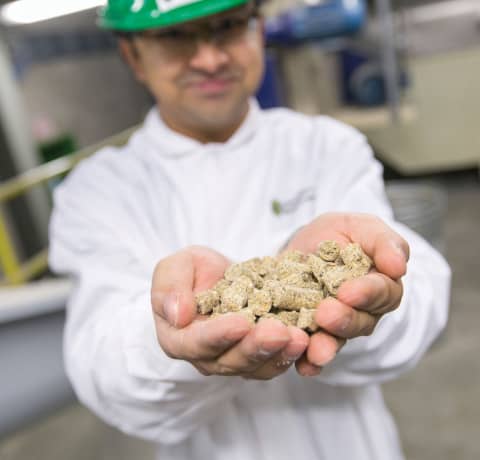
U of S students will have the opportunity to contribute to improving the quality of animal feed pellets at the CFRC.
On Oct. 24, the University of Saskatchewan Canadian Feed Research Centre (CFRC) officially opened in North Battleford, Sask.
The $13.9-million facility features equipment that will allow researchers to study and understand what is happening with animal feed, and is already being touted as one of the world’s leading centres for feed research and development.
“The university can now do research at an industrial-scale capacity, and that’s very unique in the world,” said Tom Scott, U of S research chair in feed processing technology and director of the CFRC. “I don’t think there’s another feed research facility that has pilot-scale to industrial-scale application, so it helps with commercialization of research ideas and facilitates a faster uptake of information and technology.”
The 15,650-square-foot centre was first conceptualized in 2009 when the university purchased a bankrupt feed mill in North Battleford. Construction of the facility started in September 2012.
“The idea to build such a facility at the U of S to support our work in crop development and animal nutrition goes back at least 15 years,” said Graham Scoles, associate dean of research and graduate studies. “The original intention had been to have a facility on campus but costs were prohibitive because of Saskatoon’s thriving economy. We were fortunate to come up with the innovative solution of being able to purchase a relatively new feed mill in North Battleford.”
The department of animal and poultry science in the College of Agriculture and Bioresources manages the CFRC. Both graduate and undergraduate students will participate in research and gain training and experience for careers in the feed and livestock sectors.
Starting in term two of the 2014–15 academic year, Feed Processing Concepts and Realities (ANSC 840.3) will be offered as a graduate course in Animal and Poultry Science. The course focuses on the use of feed processing to add value to feed ingredients for livestock and includes a hands-on portion which takes place at the CFRC.
“The facility is world class especially because of the unique capability for feed processing over a wide range of capacities which makes sure the results are relevant to the practical situation,” said Bernard Laarveld, a professor in the department of animal and poultry science.
The centre U of S owned but has a 10-year contract with Cargill, an American food processing company that helped fund the project and also designed and built the pilot-scale line as an in-kind contribution.
“The facility is very complex and design and construction of the research facility required the expertise of an experienced company such as Cargill that has commercial feed mills around the world,” said Scoles.
As is the usual practice with research facilities, researchers will be required to pay fees to use the CFRC. Cargill is currently licensing the use of the industrial-scale line.
“The University of Saskatchewan’s new CFRC provides an important partnership that offers a broad range of research scale capabilities — from a laboratory, to a pilot plant, to industry-scale research — which is a major advantage in attracting commercialization and engaging our industry,” said Jennifer Henderson, managing director of Cargill’s animal nutrition compound feed business in Western Canada in a press release.
“The U of S and Cargill have a longstanding relationship and both invest in communities where we are located. We are proud to be associated with the university and look forward to the capabilities the centre will offer the animal feed industry.”
The CFRC currently employs eight full-time staff and six graduate students. Scott says research at the facility is already underway.
“We have research trials to look at improving the supplement delivery to beef cattle on the range during winter by producing pellets that the animals will not waste,” Scott said. “We’re looking at the use of enzymes in canola meal to improve the feed value. We have one student working on producing a better pellet.”
Funding for the CFRC includes $5 million from the Government of Saskatchewan, $4.88 million from the Canada Foundation for Innovation, $2.46 million from Cargill, $911,544 from Western Economic Diversification Canada and $600,000 from the U of S and its suppliers.
“The CFRC’s research will be instrumental in helping our agriculture industry achieve the goals in the Saskatchewan Plan for Growth and, with that, our Livestock Strategy, which aims to increase annual livestock farm cash receipts to more than $2 billion by 2020. We are proud to support innovation and invest in this important research and training facility,” said Saskatchewan Minister of Agriculture Lyle Stewart in a statement to the Sheaf.
It is estimated that this increased processing could contribute more than $2 million to GDP through direct benefits to the crop and livestock industry.
“This is a really unique facility, particularly in Canada,” said Scott. “Most universities that have animal science typically have a feed mill but the U of S is the only one that has the equipment to do a lot of different treatment to feed.”
—
Photo: Supplied/Stobbe Photography